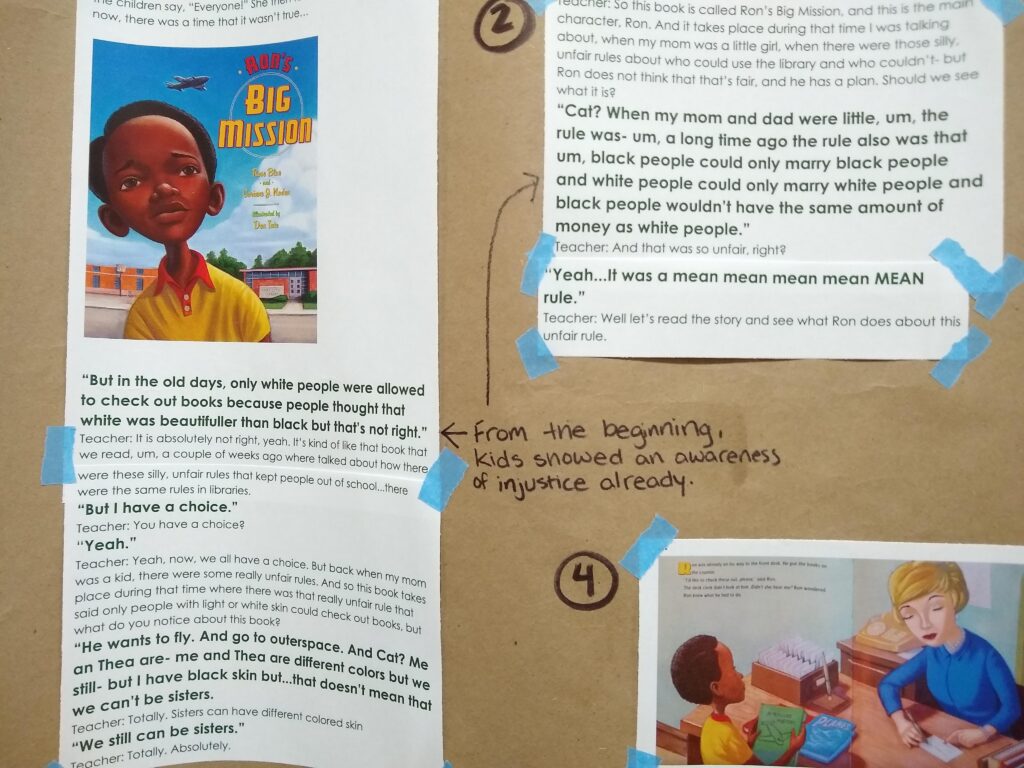
Kids are excellent observers, noticers and rememberers (Anyone who has said something regrettable in front of a child knows what I am talking about). In the last post in the series, we shared some of the ways we try to acknowledge difference in an open and celebratory way. This is important, but it’s not enough. Consider this; If we stop here- acknowledging that people are different and difference is great, but don’t also acknowledge the well-documented fact that is visible to children (whether we like it or not) that the way the world works currently is unfair to people with Black and brown skin, our children are faced with a mental dilemma. Either, the world as it is (racist), is as it should be, or the world is wrong and something must be done to fix it. How children make sense of this depends in large part on how we- parents, teachers, caregivers acknowledge injustice and empower our children to make change.
It can be intimidating to talk about the darkest parts of our country’s past and present. Fear often holds us back; we worry we will say the wrong thing and inadvertently implant racism in the mind of the child. We know that, like so much about nurturing children, “doing it well” is hard. However, like peek-a-boo, covering our eyes does not actually make the thing go away. Young children are aware of, and demonstrate, racism as early as their toddler years (like to other blog/research). Avoidance of ugly topics enables the ugly thing to persist. Fear of the discomfort of talking about white supremacy supports its perpetuation. Parents, teachers, caregivers – We do scary and hard things every day because we know they are important. We want to protect our children, but concealing an on-going threat is not protection. Moreover, our choice not to talk about our country’s racist history erases the efforts of amazing people like Ella Baker, Jo Ann Robinson and the countless students and youth who have fought for change – and whose examples can inspire children as changemakers in their here-and-now. Of course, with young children you should proceed thoughtfully and carefully, but you must proceed.
There is a wealth of resources online with great, general tips about discussing racism with children. But if you’re like me, you may be asking, What does this look like, sound like, and feel like? That’s why we are sharing a few stories of learning from our Wonder School classroom. These are meant to be examples not exemplars – and not a “to do list.” We are delighted to elevate the voices of these thoughtful children, and we are also happy to share some places where we struggled, and some of our “oops moments.” Learning and growth require struggle.
Some of this you will be able to use wholecloth (and if so, please do! Let us know what you learn!) and some will need to be modified to fit your kids, your context. Names have been changed to protect children’s and families’ privacy, and each story is greatly condensed (We removed, for example, the many times our discussions got derailed by emergency potty breaks), but otherwise this is a collection of direct quotes* and honest reflection.
This first story follows an investigation of Native American representation- specifically, how some of the stereotypes we held at the beginning of the year came to be replaced with real knowledge gained through picturebooks, photos and conversation. Not only was this one of the first, planned, in-depth anti-racist/anti-bias projects we undertook as a classroom, it ended up being incredibly personal journey of identity for one family in particular.
“I Don’t Want to be a Native American, I Want to be Normal”: Stereotype, Representation & Identity.
This post is part of an ongoing series of blog posts unpacking each of our main strategies behind anti-racist teaching with young children. In each we will share resources, including documentation from the classroom, picture books, artwork from the collection and links to resources that have been invaluable in our own efforts.
Introduction: Talking to children about racism
- Strategy 1: Self-reflection and self-education
- Strategy 2: Explicitly naming race and talking about difference in a joyful way
- Strategy 3: Talking in a developmentally appropriate way about injustices- both from the past and present.
- Strategy 4: Being intentional in choosing picture books that both feature Black, Indiginous, People of Color characters AND that are by BIPOC authors/artists.
- Strategy 5: Supporting and fostering imagination, as a powerful tool for radical social change.
** In case you’re curious- audio/video recording, transcription and note taking are a part of our daily practice as a Reggio-inspired classroom. For more information about what this could look like, see our Making Creativity Site.
– Caitlyn Lynch is CMA Lead Teaching Artist & Coordinator for Young Child Programming including Wonder School, an arts-rich laboratory preschool launched in 2018 in collaboration with Columbus State Community College, Columbus Museum of Art, and The Childhood League Center. Wonder School fosters purposeful play, critical inquiry, and a collaborative community approach to education—for children, for their educators, for a more creative and compassionate society.
